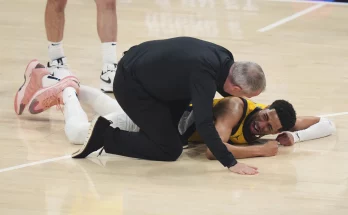Caitlin Clark’s journey through professional basketball has already taken on the aura of myth. From the moment she stepped onto the court with the Indiana Fever, the No. 1 overall pick in the 2024 WNBA Draft was met with an intensity of attention reserved for the rarest of generational talents. Her ability to score from anywhere, set the pace, and lead in big moments quickly turned heads. But now, for the first time in her decorated career, Clark faces something new: the challenge of sitting out due to injury.
A quad strain may not sound dramatic in the grand scheme of sports injuries, but when the player sidelined is the centerpiece of a franchise revival, the conversation becomes much larger. Clark missed action in early June due to what the Fever identified as a left quadriceps strain. Though not severe enough to place her on the injured reserve or trigger long-term concern, the injury has nonetheless drawn significant attention, largely because fans, broadcasters, and the league itself have come to view her presence as essential to the current narrative arc of the WNBA.
Clark had never missed a game in college due to injury. Her time at Iowa was characterized by durability, consistency, and a motor that never slowed. The very idea of Caitlin Clark being unavailable — even temporarily — is foreign to those who’ve watched her closely over the years. And yet, as with all great athletes, moments of adversity often sharpen character and leadership. For Clark, this injury has become an opportunity to grow in ways that transcend box scores.
In the games she’s missed, the Fever have tried to navigate without her engine on the floor. The offense doesn’t flow the same. The tempo shifts. Defenses play more aggressively on other guards, no longer worried about a 30-foot pull-up. And while Kelsey Mitchell, Aliyah Boston, and others have stepped up admirably, there’s no question the Fever are a different team with Clark orchestrating things. Her ability to draw defenders out to half-court changes spacing. Her eyes-in-the-back-of-her-head passes change timing. And her swagger changes confidence — both her own and that of her teammates.
But while she hasn’t been on the court, Clark has stayed close to the action. She’s remained active on the bench, sitting near the coaching staff, offering insight, reading defensive schemes, and keeping the team’s energy level high. That’s not an easy shift to make. For someone so used to leading from the floor, the adjustment to a sideline role can be jarring. Yet Clark seems to have embraced it. Observers have noted her vocal presence during timeouts and halftime adjustments. It’s a reminder that leadership isn’t always about points or assists; sometimes, it’s about presence — even when you’re wearing warmups instead of a uniform.
That presence has never been more vital. The Fever are in the middle of a season where every game feels like a referendum. That’s what happens when a transcendent player like Clark joins the league. Ticket sales skyrocket. Media coverage multiplies. Every city on the schedule treats her visit like an event. So when she’s absent, it feels like something — someone — is missing.
Clark, however, has made clear that she’s in no rush. As competitive as she is, she understands the bigger picture. Quad strains require rest and gradual reconditioning. The risk of aggravation increases exponentially when a player tries to come back too quickly. And with the Fever building toward something sustainable — not just a good season, but a legitimate multi-year contender — the emphasis is on long-term health, not short-term adrenaline.
By all indications, her return is near. Clark has reportedly resumed light workouts, and her mobility is steadily improving. The Fever’s medical staff has been cautious but optimistic. She’s expected to be reevaluated over the weekend, and there’s a growing belief she could return as soon as the team’s next road trip. That could come early next week, depending on how her quad responds to increased activity.
For Clark, the injury may have offered something she didn’t expect: perspective. Throughout her career, everything has been go-go-go — from her rise at Iowa to the whirlwind of her rookie season. Sitting out, even for a week or two, forces a different view. Watching her team from the bench, observing tempo and spacing from a different angle, studying opposing defenses without being the one they’re targeting — these experiences can’t be replicated on the court. And for a basketball mind as sharp as Clark’s, there’s every chance this enforced pause will enrich her understanding of the pro game.
Meanwhile, the league marches on — but it does so with slightly less buzz when she’s not suiting up. Television ratings have soared with Clark’s arrival in the league. She brings new viewers, young fans, and an entirely different demographic into the fold. Whether that’s fair or not is a separate debate. But it’s the reality. The WNBA’s 2024 and 2025 seasons have been defined in part by her presence — just as the NBA was once defined by Magic, Bird, or LeBron in their early years.
When she returns, that attention will only intensify. The first game back after any injury is always scrutinized — how she runs, whether her explosiveness is the same, how long her minutes are limited. But Clark will likely tune out the noise, just as she has since she first started drawing national headlines. She’s built her game on confidence and creativity, and there’s no reason to believe either has faded during her time off.
The timing of her return could be pivotal. The Fever are entering a stretch of the season where playoff positioning begins to take shape. Every win matters. Every lineup tweak matters. And having Clark back on the floor could be the spark they need. Her chemistry with Aliyah Boston continues to develop, and her ability to get shooters like Mitchell or NaLyssa Smith open looks is unparalleled. Simply put, when Clark plays, the Fever’s ceiling rises.
There’s also the emotional element. Clark is not just a competitor — she thrives on the moment. The idea of watching games from the sideline isn’t just frustrating; it’s fuel. She’ll come back hungry. That’s the nature of stars. Setbacks don’t diminish them. They refine them. And for Clark, this injury could serve as the spark to push even harder in the second half of the season.
Fans will be waiting — not just in Indiana, but in every city the Fever travel to. Her road games have drawn sellouts. Her jerseys are everywhere. She’s not just a player; she’s become a symbol of what’s possible when talent meets platform. And while the quad strain may have paused the story for a chapter, it hasn’t changed the narrative.
If anything, it’s added a new layer. Now, Caitlin Clark returns not just as a rookie sensation, but as someone who’s had to regroup, reflect, and reload. That evolution — from constant performer to sideline strategist and back again — is what builds legends. The comeback isn’t just about scoring again or throwing a no-look dime. It’s about reminding everyone that even the best sometimes need a moment — and that greatness, ultimately, is measured in how you respond when you finally get back up.
So when she finally steps back onto the court — whenever that moment comes — it won’t just be a return. It will be a continuation. A resumption of something bigger than just one player or one team. Caitlin Clark is coming back, and with her comes the next chapter of a story that’s only just begun.



